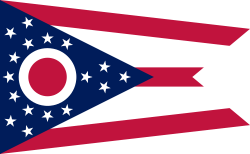Flag of Ohio

The flag of the state of Ohio was adopted in 1902 and designed by John Eisemann, for the 1901 Pan-American Exposition.
The large blue triangle represents Ohio's hills and valleys, and the stripes represent roads and waterways. The five stripes also represent that Ohio is one of the five states that comprised the Northwest Territory (Ohio, Michigan, Indiana, Illinois, and Wisconsin). The 17 stars symbolize that Ohio was the 17th state admitted to the union. The 13 stars on the left, above, and below the circle are for the 13 original colonies of the United States. The white circle with its red center not only represents the first letter of the state's name, but also its nickname, "the Buckeye State."Drawn by John Eisemann, architect and designer for the Ohio State Pan-American Exposition Commission, it is the only American state flag that is non-rectangular, and one of only two non-rectangular official jurisdictional flags, at the state level or above, in the world (the other is the flag of Nepal). Loosely based upon the design of cavalry flags of the Civil War and Spanish-American War, the proper name for this type of flag is burgee.The flag forms the basis of the logo of the NHL hockey team, the Columbus Blue Jackets. It is also regularly flown by the Ohio State University Marching Band during football games. Specifically, the flag is flown by the percussion section of the band (JI-Row) which has embraced the flag as its personal mascot.
© Symbols.com
